Cross-team collaboration encourages employees to align their efforts and contribute meaningfully to shared company goals.
Creating a culture of open communication and information sharing is particularly important in SMBs where lean teams and tight resources make every contribution matter.
In this article, you’ll learn what effective cross-functional collaboration looks like and how to improve it. You’ll also discover the role of technology and how tools like Pipedrive and AI keep teams on track and boost productivity.
What is cross-team collaboration?
Cross-team collaboration happens when employees from different departments work together towards a shared goal using open communication, shared responsibility and collective problem-solving.
This approach is mission-critical in small businesses and remote teams where resources may be limited and workflows are naturally decentralized.
Here’s what cross-team collaboration looks like at a startup SaaS company where employees hold multiple roles:
The founder or tech lead provides technical expertise, showing customer-facing employees how clients can use the product’s features to solve specific pain points
The lone member of the sales team collaborates with a marketing agency to explain customer needs and refine messaging
The sales lead shares sales objections with the founder to shape the tool’s value proposition and development roadmap
The customer success lead, who is also responsible for billing, meets with the founder every month to run through churn rates and payment queries
Open communication and teamwork prevent information siloing, helping everyone juggle multiple responsibilities successfully.
What are the benefits of cross-team collaboration?
Increasing teamwork between departments helps small businesses boost productivity, improve workplace culture and deliver better, more consistent customer experiences.
Here are three benefits of cross-team collaboration for SMBs.
1. More open communication, fewer siloes and higher productivity levels
According to McKinsey research, collaborative teams complete projects 20% to 25% faster. They share knowledge, solve problems and are more productive by using technology to enhance collaboration.
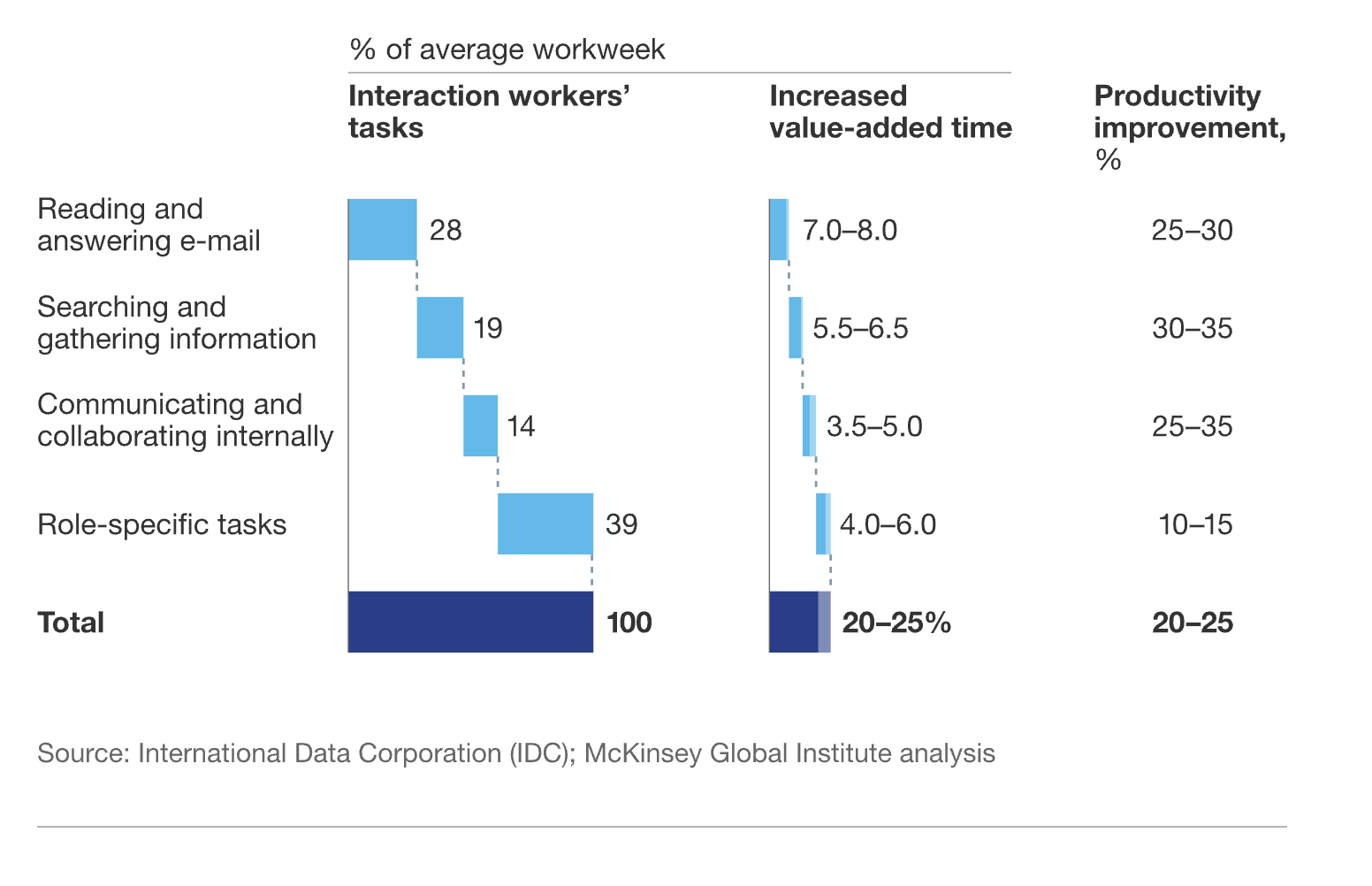
Clear communication breaks down information siloes, making departments less likely to duplicate their work and better able to keep cross-functional projects moving forward.
Shared data also improves decision-making by ensuring all teams can access the same insights.
For example, when the marketing department shares lead reporting data with sales reps, they won’t waste time on unqualified prospects. Similarly, customer support teams that relay customer feedback to developers help them inform and accelerate product roadmaps.
2. Happier workplaces and higher talent retention rates
Employees thrive in workplaces that encourage cross-team collaboration. Like team-building activities, cross-team collaboration efforts boost employee engagement, build trust and create a better corporate culture.
A strong workplace culture will help you hang on to employees, too. Research by MIT Sloan finds that corporate culture is a more reliable predictor of employee attrition than wages.
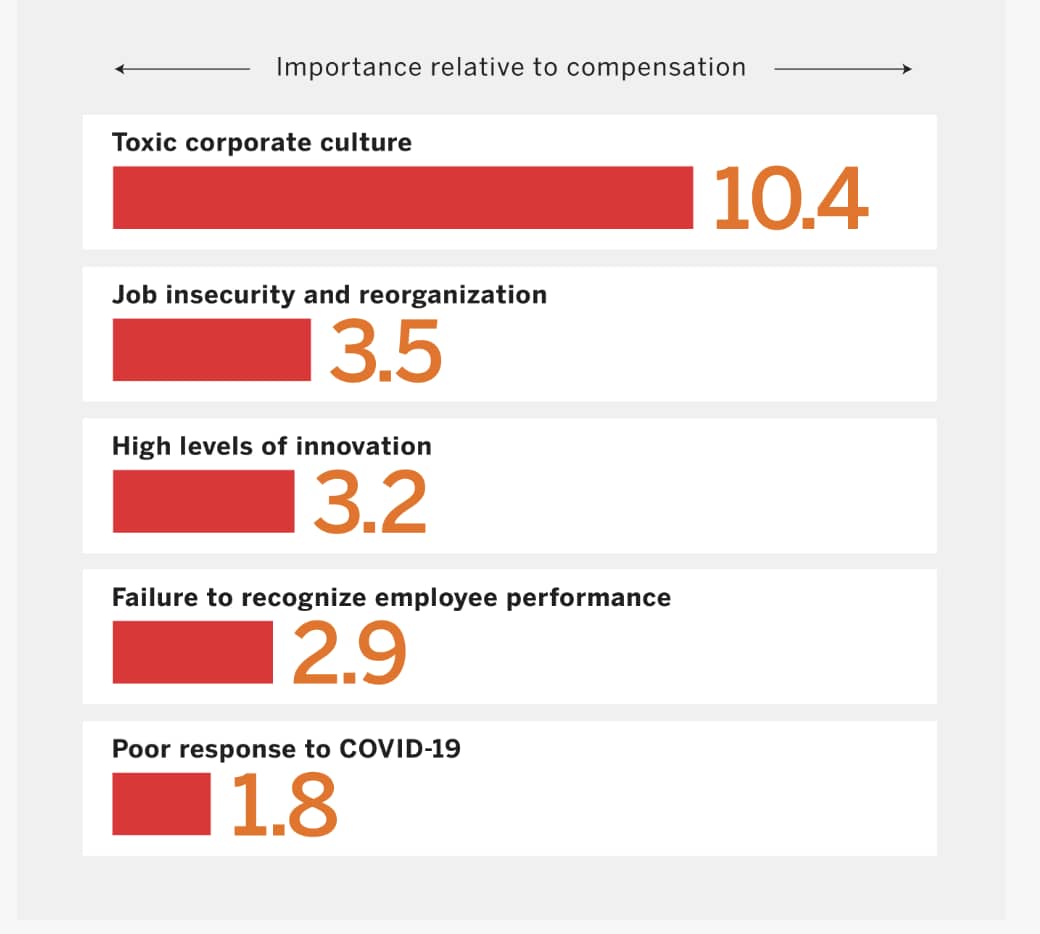
Culture is also a compelling factor for younger employees. An EY survey of US workers found that nearly four in 10 Gen Z and millennials say it significantly impacts their intent to stay at their current workplace.
Cross-team collaboration directly improves culture by breaking down departmental barriers and creating shared wins, which younger workers value.
The benefits of collaborating with cross-functional teams also add up over time. Long-time employees find collaborating easier, improving workplace happiness and retention rates.
3. Better alignment and more consistent customer experiences
According to research by Forrester, a lack of organizational cooperation is the biggest impediment to improving the customer experience.
When different teams work together towards a shared goal and communicate openly, they’ll naturally deliver a consistent customer experience that contributes to your brand story, increases customer trust and boosts sales.
When sales and marketing align on their target audience’s pain points, they deliver consistent and relevant messages that reduce friction and keep prospects moving through the sales funnel.
5 ways to achieve cross-team collaboration
To enjoy the benefits of cross-team collaboration, you must align teams, increase communication and improve knowledge sharing throughout your small business.
Use these five cross-functional team collaboration strategies to build cooperative teams without tearing up your existing workflows or hiring expensive outside consultants.
1. Create shared goals to align teams
Start every cross-departmental project or initiative by clearly defining what you want to achieve. A common goal helps teams work together and align their work with company objectives.
Uniting behind clear goals also eliminates territorial behavior and cross-departmental competition. Rather than competing to find the right prospects, marketing and sales work together to close sales.
How to achieve it
Use the objective and key results (OKRs) framework to create a big-picture business goal and smaller milestones or sales metrics that let each department track its progress.
For SMBs, OKRs focus scarce resources on the most valuable business activities.
For example, a software company that wants to expand its business by launching a new product might set key results, such as generating 50 new leads per quarter.
Since they rely on marketing to drive growth, they also aim for 75% of those leads – marketing-qualified leads (MQLs) – to be validated by the sales team as sales-qualified leads (SQLs). The company might also target 95% customer satisfaction to maintain quality as it scales.
In action, creating relevant OKRs means:
Breaking down your big vision into a set of short-term tasks and objectives for each department to make progress visible and more realistic
Making the process even more collaborative by involving each team at the start of the process to ensure you get buy-in
Setting individual and departmental goals (like sales commission), while also creating company-wide initiatives like a bonus scheme that rewards all employees fairly
Remember to celebrate each department’s achievements across the business to boost teamwork and reinforce each department’s role in helping your company meet its goals.
Download your guide to managing teams and scaling sales
2. Invest in tools to boost communication and collaboration
Long email chains, project bottlenecks and missed deadlines happen in businesses of every size. Collaboration tools stop them from becoming major roadblocks for small teams that might otherwise struggle to play catch-up.
Technologies like project management software and video conferencing let small teams be even more agile than larger competitors and complete every project on time.
For example, a shared project dashboard like the one below makes it easy to see each task’s owner and status:
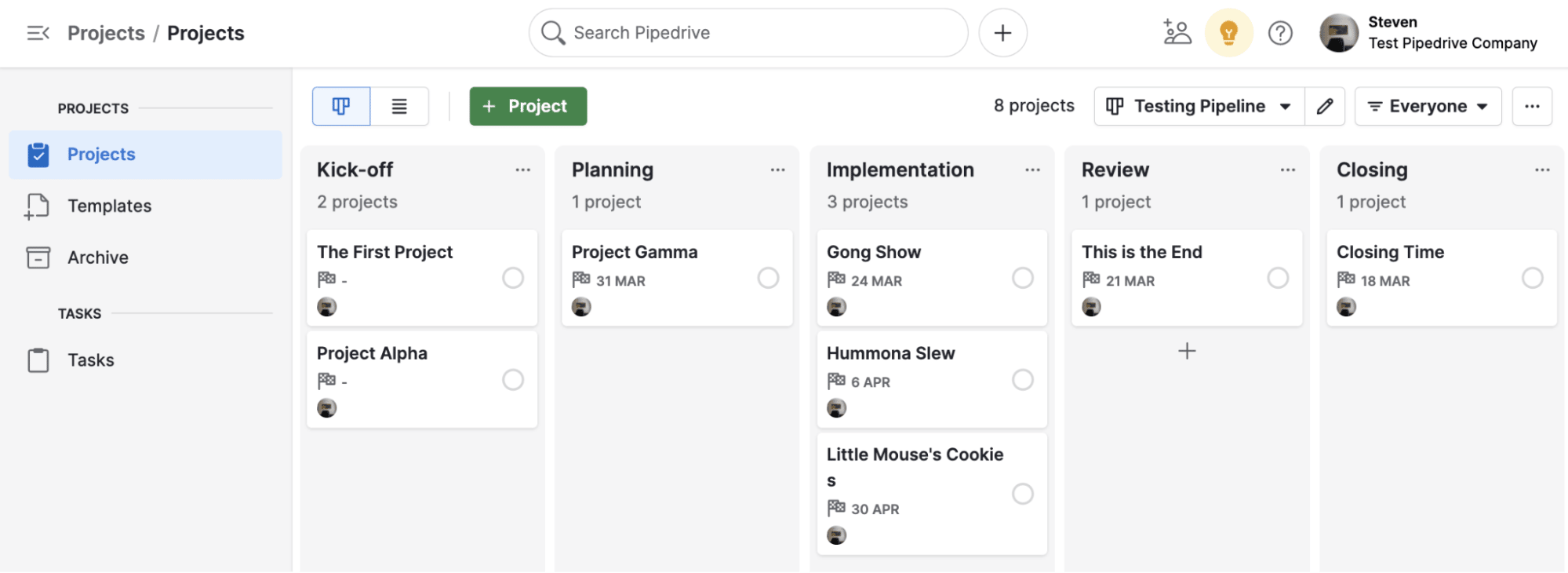
Here are three essential collaboration tools for small businesses seeking to eliminate data silos and enhance their communication plan.
Technology | Role |
CRM software | A customer relationship management (CRM) system creates a single source of truth that eliminates confusion and accelerates processes through automated workflows. |
Communication channels | A dedicated messaging app like Slack eliminates messy email chains and keeps everyone in the loop. Video conferencing software like Zoom makes internal meetings more practical, particularly for remote companies. Teams working across different time zones can use Loom for asynchronous communication. |
Employees use task management tools like Asana to check project statuses quickly, see who’s responsible for a task and access files other departments upload. |
SMBs can purchase tools on subscription, meaning they don’t have to invest in expensive one-off solutions to improve collaboration.
How to achieve it
Choose the best collaboration tools for your company by considering:
Ease of use. Does the tool have a clean navigation and a simple interface that every employee can use?
Scalability. Will the tool grow with your business and adapt to evolving workflows?
Integrations. How well does the tool integrate with your existing business apps?
Support. What support is available, and what does the onboarding process look like?
However, be careful when implementing too many tools simultaneously, as it may make it harder for teams to keep track of tasks.
Note: Make collaboration even easier for your team by choosing software that integrates with other apps. For example, Pipedrive is a CRM with project management features and integrates with tools like Slack, helping small businesses centralize work and minimize software subscriptions.
3. Systematize and automate workflows
Everyone has different perspectives and working styles, but systematized and automated workflows remove ambiguity from cross-departmental tasks.
By clearly defining processes and responsibilities, there’s less risk of duplicated work or essential tasks falling through the cracks. Teams can leverage diverse skill sets while everyone takes responsibility for tasks, and work progresses smoothly.
Workflow automation streamlines processes, handling monotonous tasks like notifying someone that a piece of work is ready for your review.
Project management tools often let you create automations using pre-defined triggers. Here’s what it looks like in Pipedrive:
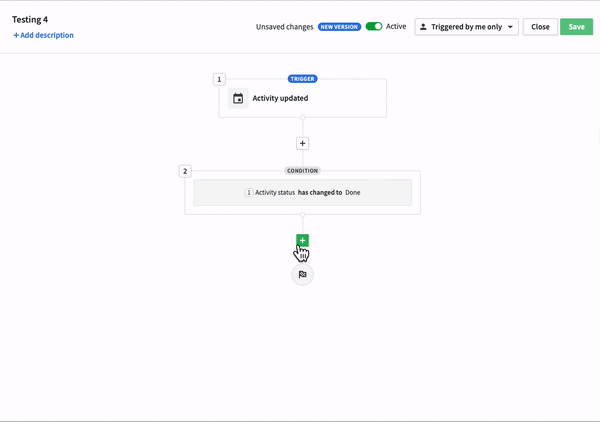
GP Law Group, an LA-based personal injury and mass tort litigation firm, shows how automation transforms collaboration. Since centralizing work in Pipedrive, they’ve increased their caseload by 160% and doubled team size.
Their automated workflows ensure they never miss filing deadlines by:
Populating each new deal with pinned notes for maximum visibility of important case information, like treatment plan, status of medical records and status of negotiations
Creating calendar events when the team adds essential dates, like the Statute of Limitations (SOLs), to deals
Pushing important activities to Slack, where the team holds each other accountable
Centralizing and automating work on the platform improves collaboration and speeds up client onboarding.
How to achieve it
Start systematizing processes by identifying critical and repeatable workflows. For every department:
Document the process. Write down each task employees must complete, including step-by-step instructions that make it easy for a new hire to complete the task.
Standardize procedures. Add templates, best practices and examples that help employees complete tasks similarly.
Automate repetitive tasks. Use existing software to automate manual processes, such as assigning a task to an employee or creating a due date.
Assign roles and responsibilities. Add job titles and names next to every task in your workflow.
You now have a set of standard operating procedures (SOPs) that employees can use to complete a task or learn how another department works.
4. Make resources accessible to everyone
Assets like your SOPs are only helpful if everyone can access them. A knowledge management system (KMS) can organize internal information into an easily accessible repository where teams can find and share it.
This central hub removes information barriers between departments, aligning everyone around the same playbook for a consistent customer experience.
As well as SOPs, a KMS holds all your organization’s most important data:
Job descriptions
Brand and editorial guidelines
For example, adding buyer personas and ideal customer profiles (ICPs) to your KMS ensures marketing and sales teams focus their messaging on similar topics relevant to your target audience’s needs.
How to achieve it
Several dedicated knowledge management software solutions, like HelpScout, and cloud-based storage solutions, like Google Drive, are available. However, any platform that stores or organizes information works as a knowledge repository.
For example, create a KMS using Pipedrive Smart Docs. It integrates with your CRM, meaning you can autofill documents with sales data, and it comes with user access permissions, so you can decide exactly which documents each team views.
Whichever tool you use, make your system as intuitive as possible using document hierarchies and hyperlinks to help users quickly find the necessary information.
5. Collect and action employee feedback
Frontline employees are often the first to spot collaboration issues like redundant meetings or overly complex workflows. Get their opinion to find and fix roadblocks that stop your team from working together efficiently.
Employee feedback systems, such as surveys and suggestion boxes, foster open communication and help create a culture where everyone feels heard.
How to achieve it
Gather employee input with:
Employee surveys. Use a tool like SurveyMonkey to create a collaboration-based questionnaire that gets sent to staff automatically every month
In-person meetings. Hold regular check-ins with employees or team meetings to discuss ways they think collaboration can improve
Suggestion boxes. Encourage team leaders to create an anonymous suggestion box in their department where employees can leave feedback and propose ideas
Employees are more likely to provide feedback if it leads to fundamental changes. Share your improvement plans every month or quarter and follow through promptly to demonstrate your commitment to collaboration.
How to boost collaboration efforts with Pipedrive
Pipedrive is a CRM that centralizes all of your sales and customer data, increasing accessibility and making it easier for separate teams to work together towards shared goals.
For example, Pipedrive’s Contacts timeline, shown below, offers a complete history of customer interactions that sales and customer success (CS) teams use to align themselves during the customer onboarding.
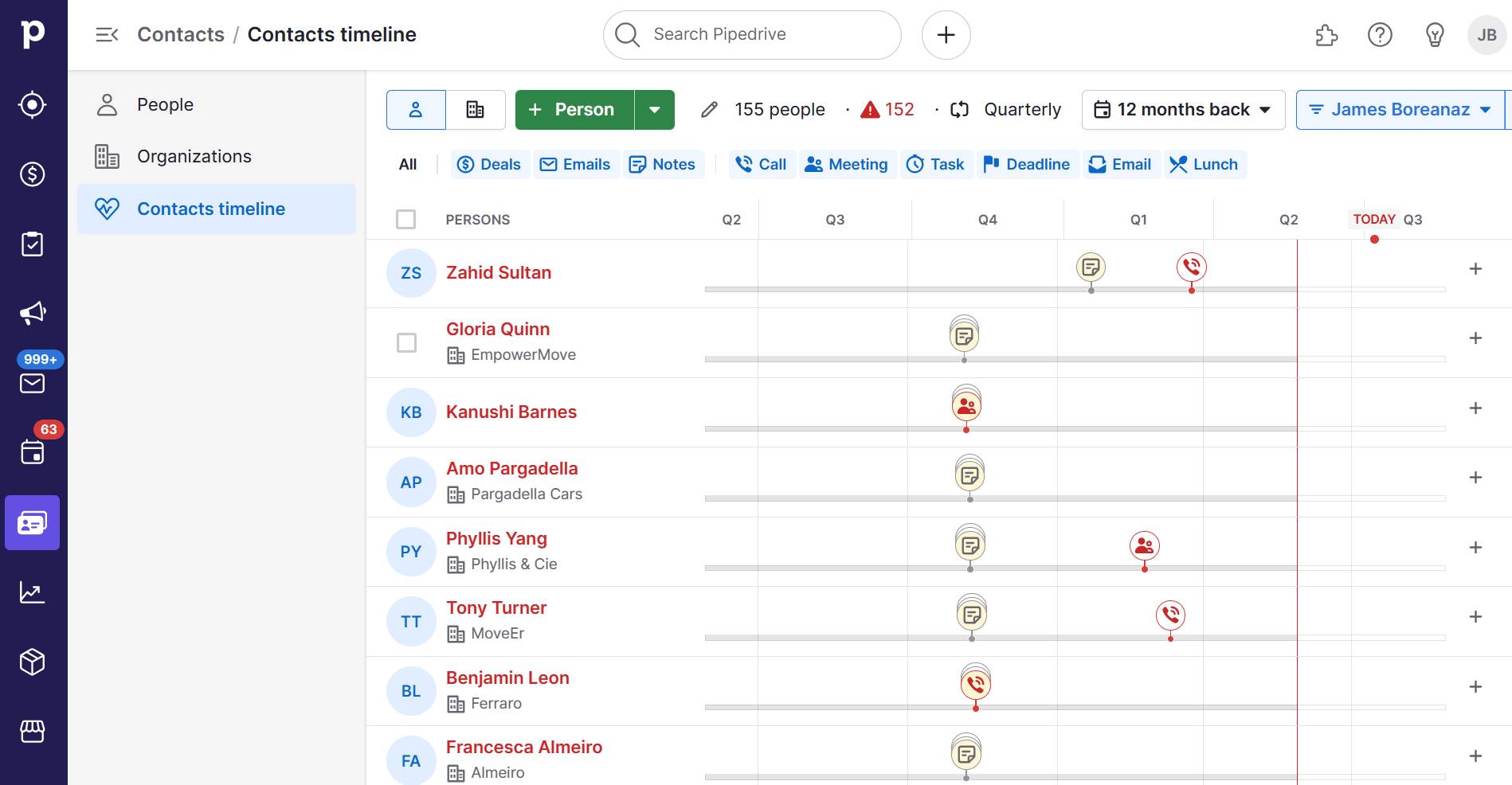
The timeline gives CS teams access to every interaction, allowing them to learn which features customers care about and tailor the onboarding process. It’s easy to see which sales rep to contact if customers need clarification.
Pipedrive does more for collaboration than centralizing sales data, though. Here are three other ways to use the platform to help teams in your small business work more effectively together.
Optimize post-sales delivery processes using project management tools
Projects by Pipedrive is a project management software available on Power and Enterprise plans and as an add-on for Professional accounts and lower.
Companies use it to bridge the gap between sales and delivery teams, helping with onboarding and project completion as soon as they finalize a deal.
For example, a digital marketing agency can use Projects to set up a new client workflow every time its sales team closes a deal. It can assign, track and complete regular marketing tasks, like creating blog posts and social media assets, without using another tool.
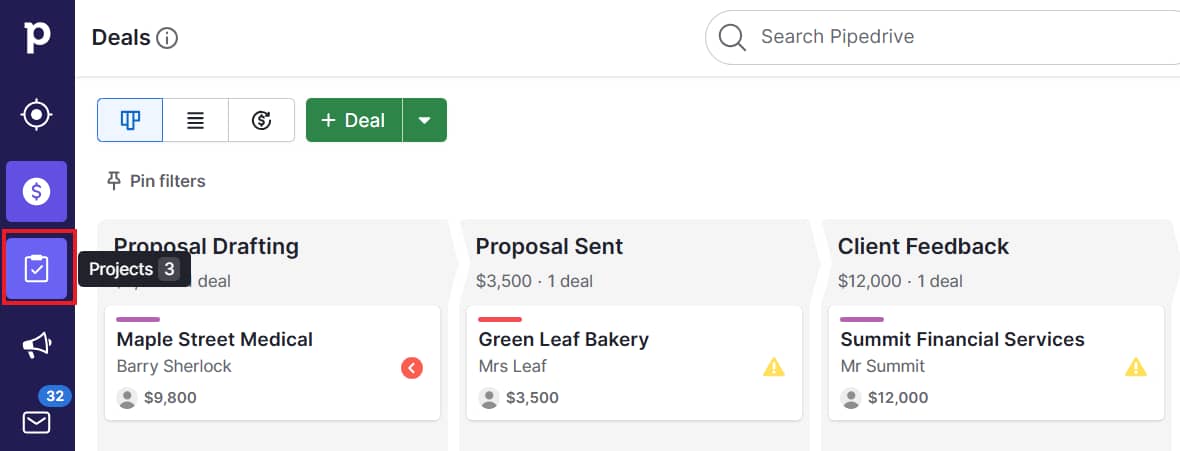
Pipedrive’s Projects has several features that increase cross-team collaboration, including:
A centralized workspace that brings all project-related information, such as tasks, documents and timelines, into one place
A kanban-style board so team members see the status of live projects at a glance, increasing visibility and accountability
Task assignment and tracking capabilities so everyone knows their responsibilities and how their tasks contribute to the bigger picture
Communication tools like notes, comments and mentions to encourage in-app knowledge sharing and reduce context switching
Project templates that ensure standardized workflows and save time at the start of projects
This project management tool also syncs with Pipedrive’s CRM, meaning your team doesn’t have to switch between different tools. This integration simplifies small business workflows while reducing the risk of tool fatigue and data loss.
Streamline hand-offs between departments with workflow automation
Pipedrive’s Automations feature helps you automate the repetitive manual parts of your processes to reduce errors, increase productivity and ensure work moves smoothly from one department to the next.
For example, create an automation that automatically transfers the ownership of a deal between marketing and sales teams once it reaches a certain point in your sales pipeline. Another trigger can then transfer ownership from sales to customer success once you sign the contract.
Here’s what creating a trigger in Pipedrive looks like:

Automating hand-offs ensures that no deal slips through the cracks and every team member has the information they need to complete their task.
Increase collaboration and communication with tool integrations
Pipedrive integrates with hundreds of business apps to eliminate data silos, automate processes and increase team communication.
Here are a few examples of how to use three popular communication and collaboration tools with Pipedrive:
Asana – keep teams up to date with sales developments by automatically updating tasks when a deal’s status changes
Trello – increase information flow and eliminate human error by automatically attaching customer information from Pipedrive to task cards
Slack – improve communication by creating automatic alerts about important activities, like a new deal
Use SmartApps, Pipedrive’s AI-powered recommendation engine, to suggest relevant integrations based on your existing workflows.
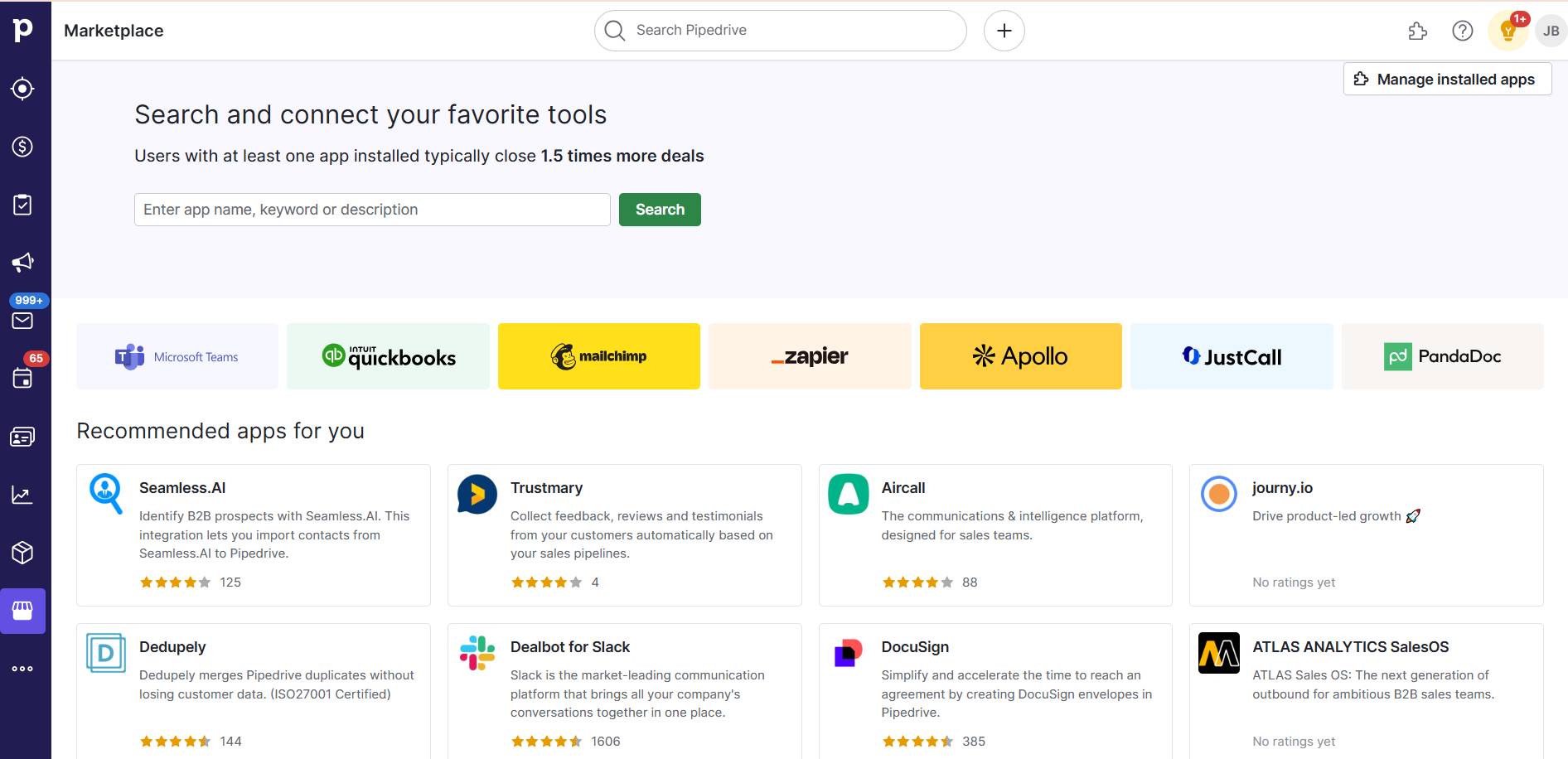
You can also manually search for apps. Pipedrive’s AI-powered search feature will recognize natural language queries to find the perfect tool integration, even if you don’t use the exact terminology.
Why AI should be part of cross-team collaboration
AI solves cross-team collaboration challenges in small businesses by breaking down communication silos, enabling real-time insights and automating routine tasks to increase efficiency and alignment across various departments.
Here’s how AI can be part of cross-team collaboration.
Keep teams on track with AI project managers
AI agents act as project managers, automating routine tasks, sending reminders and automatically scheduling work. They reduce manual workload and human error, ensuring cross-team projects stay on track.
Here are some of the ways AI improves project management:
Analyze project data to identify potential delays and bottlenecks
Send reminders and suggest actions when employees miss task deadlines
Summarize project information, allowing employees to grasp essential details quickly
Pipedrive’s Sales Assistant acts as an all-in-one sales-focused AI agent. It does everything from recommending actions on deals to summarizing lengthy email threads.
For example, customer success teams use the email summarization tool to quickly understand what customers liked during the product demo and help them achieve their goals:
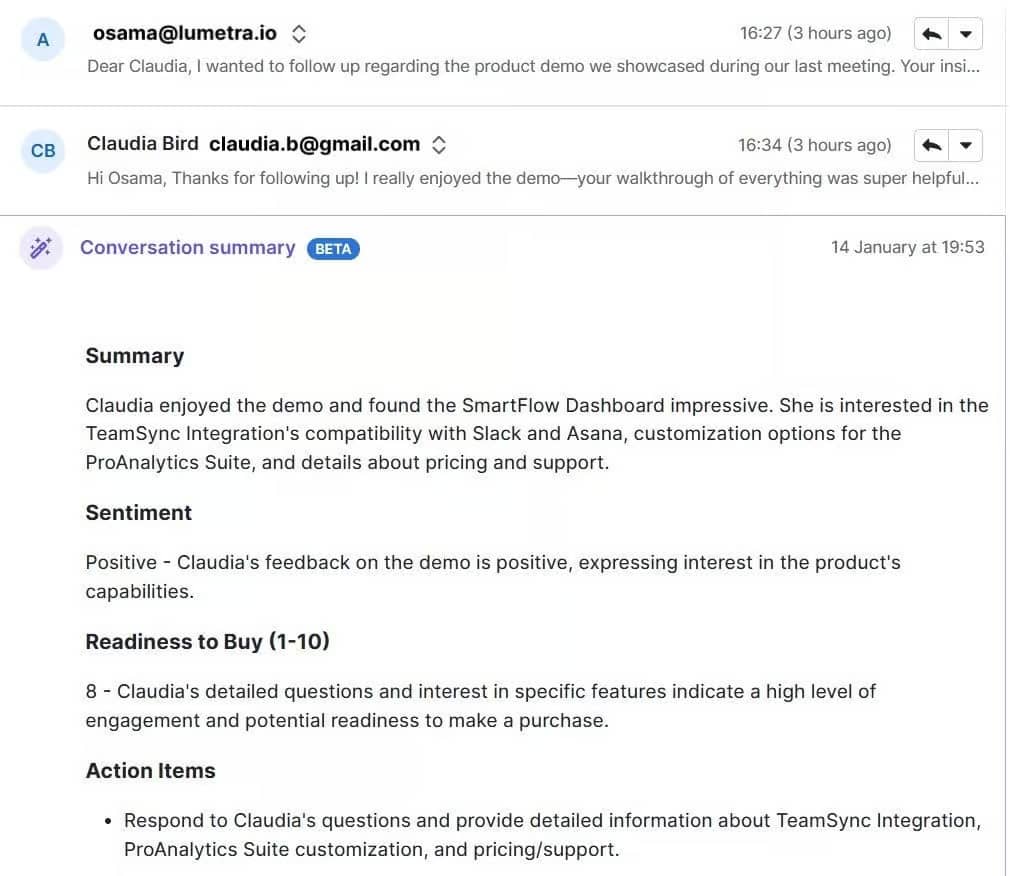
Sales Assistant improves task management and increases productivity, meaning fewer bottlenecks and delays in sales-focused workflows.
Increase information flow with AI insights
AI-powered analysis improves cross-team collaboration by unlocking insights and increasing access to information. Artificial intelligence analyzes data sets much faster than humans, spotting trends they might miss.
It also makes sharing and consuming those trends easier using AI dashboards and reports. For example, Piperdrive’s AI report generator lets teams ask simple questions about vast data sets.
This automation means marketing teams don’t have to wait for sales to discuss lead quality. Using a text-based prompt like the following gives a real-time answer from Pipedrive Insights instead:
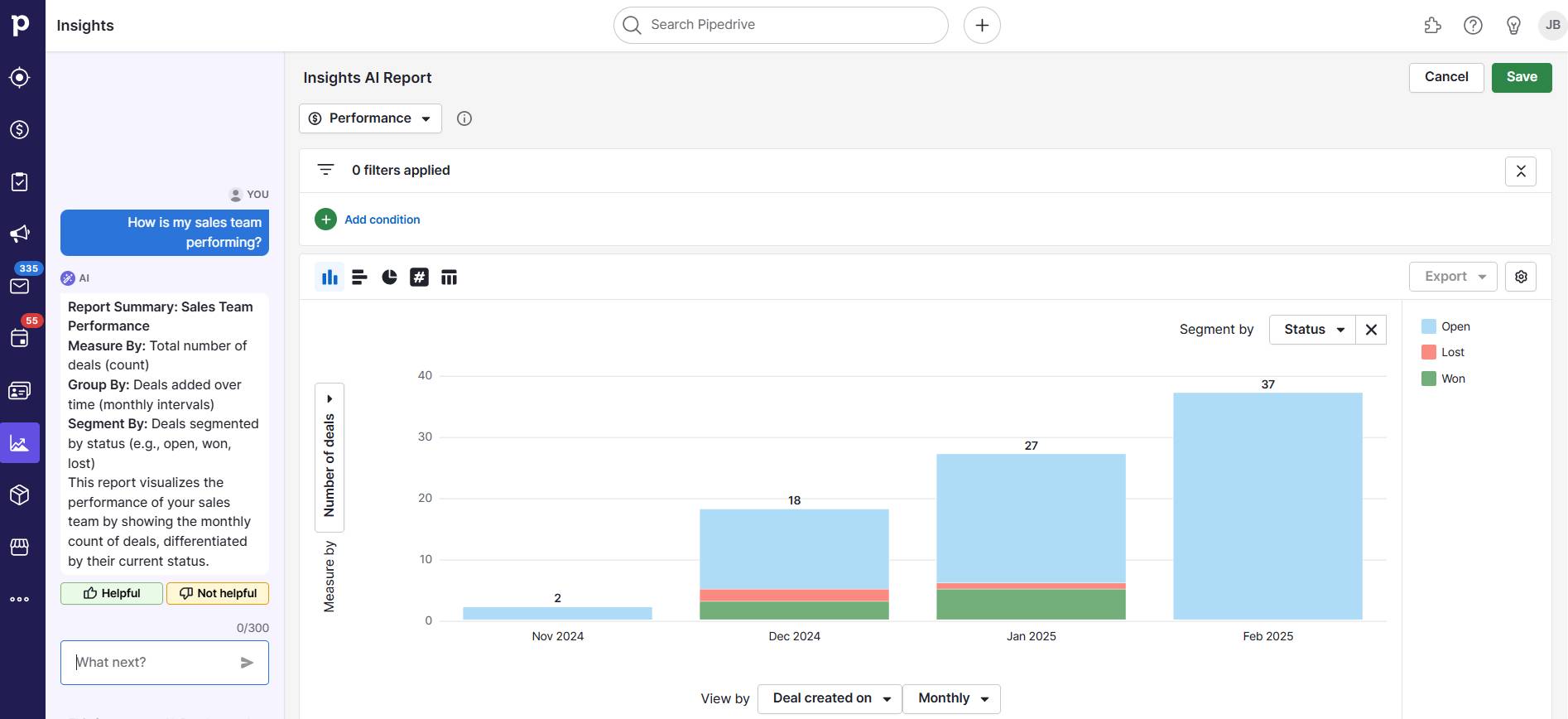
By automating information retrieval and accelerating analysis, AI keeps information flowing across departments, ensuring each team completes tasks on time and to a high standard.
Boost productivity with generative AI
A novel way to strengthen cross-team collaboration is by using generative AI as a virtual teammate that helps with supporting tasks, such as brainstorming ideas and creating content.
AI handles tasks others don’t have time for, reducing bottlenecks and freeing up teams to focus on higher-value tasks.
For instance, if sales teams are always waiting on marketing for outreach emails or one-pagers, ChatGPT can help generate content quickly, freeing up marketing’s time and accelerating sales.
Pipedrive’s AI email writer takes this further by crafting engaging and personalized messaging that sales reps can send without waiting for input from other teams.
To reach out to a sales prospect, they can simply give the tool a short prompt:
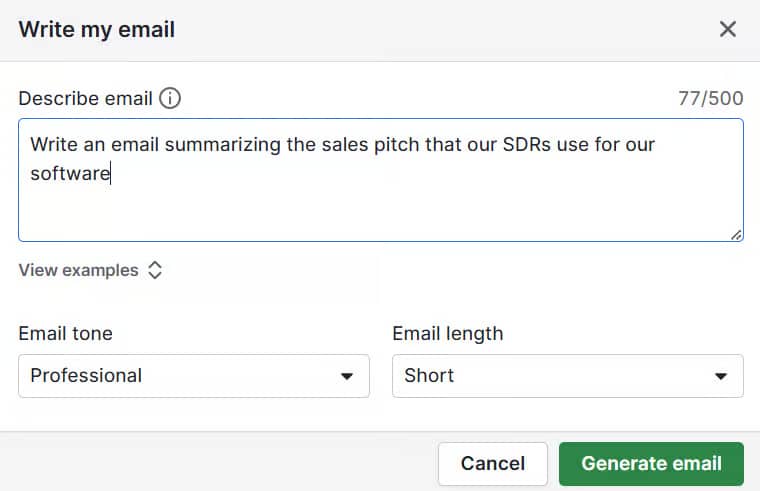
The employee can then tweak the output to get the desired effect and personalize it with data from Piperdrive’s CRM.
Final thoughts
Cross-team collaboration helps small businesses stay aligned and productive, even with limited resources. With the right tools and a culture of open communication, teams tackle and achieve ambitious goals together.
With AI, it becomes even easier to streamline workflows, share insights and improve productivity.
Pipedrive combines AI and collaboration tools into a single platform that gives small businesses everything teams need to work well together. Improve collaboration in your SMB by signing up for a 14-day free trial.









